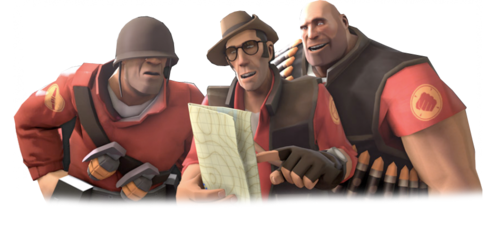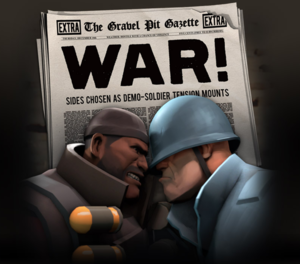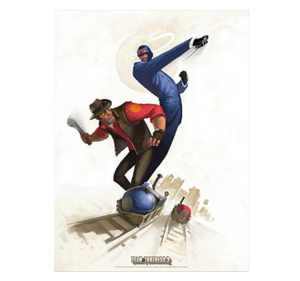チーム戦術
| このページの内容は日本語へ翻訳中です。 もしあなたが日本語話者で編集して頂ける場合は、トークページにその旨を記していただくか(編集履歴のページを参照して)このページを過去に編集した人たちと話してください。 |

| 「 | 驚くべき殺戮だった... 敵のチームによるな!
聴く (英語)
— ソルジャー、チーム戦術を誤った
|
」 |
Team Fortress 2では、チームがばらばらに動いていては敵のチームに勝利することは困難です。そして、それはあなたひとりだけでは本質的に不可能です。他のクラスと協力して動くことは、勝利するための重要な側面でもあります。この記事では、あなたとあなたのチームの役に立つであろうチーム戦術を紹介します。自身の立ち回り方を向上させたい場合は、戦術を参照してください。マップ特有の戦術はそれぞれのマップのページを参照してください。
目次
一般戦術
情報伝達
Team Fortressはミニマップが存在しないクラスベースのゲームであるため、勝利をつかむためには情報伝達と協力は常に重要な要素となります。チームプレイヤーとの正しいクラスバランスの調整は常にチームを勝利へと導くでしょう。スキルレベルの如何を問わず、情報伝達とは知っておくべき最も重要な能力です。TeamSpeakやインゲームボイスチャットなどを使用し、優れた情報伝達と同調性を持ったチームならば、チームワークが不足している熟練プレイヤーを負かすことも可能です。効果的なチームコミュニケーションと調和は、競技性の高い場で特に望まれます。
ボイスコマンドとテキストメッセージは非常に便利なコミュニケーション方法です。しかし、ゲーム中には多くのサウンドが鳴っている上に、ボイスコマンドがチームメイトに聞こえるかはキャラクターの位置が影響します。チームチャットに注意を払わないプレイヤーもいるため、マイクによるコミュニケーションが常に信頼出来る方法となるでしょう。例えば、変装した敵スパイの位置、敵のセントリー基地の場所、粘着爆弾のトラップ、攻撃やユーバーチャージのタイミングなどの重要な情報は、単純にボイスチャットを使用しなければ伝達が困難です。
しかしながら、オールトーク機能を有効にしているサーバがあることも念頭に置く必要があります。オールトークとは、サーバにいる全プレイヤーが全員の声が聞こえるようになる機能で、敵チームの声も聞こえるようになります。そのような状況でボイスチャットを使って重要性の高い情報を共有すると、敵にあなたの攻撃を迎え撃つ準備を与えてしまうため、テキストチャットを使うのがベストな手段となるでしょう。一般的にオールトークは、競技性の高いチームプレイよりもプレイヤー同士の交流に重点を置いてゲームをプレイしているパブリックサーバで有効になっています。
チーム構成
Team Fortress 2は、チームが勝利するためにはチームのプレイヤーが協力し、調和することが不可欠なクラスベースのチーム戦です。9種類の異なったクラスには、それぞれ長所と短所があり、長所を最大限に生かして短所を最小限にする固有のプレイスタイルがあります。しかしながら、プレイヤーがどれだけ熟練していたとしても、プレイしているクラスの短所を完全に補うことは不可能です。あるプレイヤーが他のプレイヤーよりも技量が低かったとしても、相手よりも有利なクラスで対峙することで勝つことが可能です(例えば、技量の低いパイロが熟練したスパイを倒す)。これは、どのクラスでプレイするかという選択を非常に重要なものにしており、プレイヤーはそれぞれのクラスをよく知ることでその恩恵を受けることになります。それにより協力も等しく重要なものになっています。これは、非常に複雑なじゃんけんと考えることが出来るでしょう。
多くの新規プレイヤーが陥りやすい間違いは、Team Fortress 2のチーム的要素を無視して、好きなクラスでの1対1の対戦の戦術を考えることにのみ集中することです。しかしながら、Team Fortress 2での戦闘のほとんどは、多様なクラスを含んだグループ同士のぶつかり合いです。したがって、勝利するためにはひとりひとりが単体ではなくチームとして動くことが不可欠です。これは、現在のあなたのチームだけではなく、相手チームを構成するクラスにも注意を払うことが含まれています。これがチーム構成と呼ばれるものです。敵チームのクラスのカウンターとなるクラスを何人かのプレイヤーが選ぶことで、アドバンテージを得ることも出来ます(例、 多くのエンジニアがいるために大量にあるセントリーガンに対抗してデモマンとメディックのコンボを使う)。しかしながら、クラスを変えることに必要以上の人数を割いてしまわないことも重要です。(例、スパイに悩まされているチームが大勢パイロに変える、これではクラスの多様性を失うためにチームが脆弱になる)。チームの現在のクラスを頭に入れておくために、スコアボードを定期的にチェックし、それに応じて調整を促すのは良い考えです。しかし、必要であらばあなたが自らクラスを変更しなければなりません。
実践
たった一つのクラスだけではなく、複数のクラスに慣れておくことは重要です。クラスが持つ長所と短所を知っておけば、別のクラスに変更する良いタイミングが判断できるようになります。また、それぞれのクラスが持っている役割を知っておくことも重要です。例えば、あなたのチームにいる唯一のエンジニアがメディックに変更すれば、敵の機密情報を取りに行く戦力になりますが、良い考えとは言えません。CTFマップにおいては、機密情報を防衛することも奪取することと等しく重要だからです。一般的に、あなたが既に重要な役割を果たしていない限り、「誰かメディックになってくれ」と発言するよりも、あなたがメディックに変更してその需要を満たす方が良い考えです。
一方で、少なくともあなたが一年以上ゲームをプレイしているか、既に十分な経験を詰んでいない限り、全てのクラスにおいてエキスパートになろうとするのは良い考えではありません。これは、それが非常に難しいという理由だけでなく、慣れていないクラスをゲーム中にプレイすることで、味方のがんばりを助けるどころか邪魔してしまうかもしれないからです。何もマスターしていないが全てのクラスがそこそこ使えるよりは、2つか3つのクラスでスペシャリストとなり、他の1つか2つがそれなりに良い状態であった方がチームにとっては有益です。
どんな戦略があなたのプレイスタイルに合っているかを模索しましょう。そして、それらのクラスやそれに似ているクラスであなたのスキルを上達させましょう。例えば、誰もが上手にスパイをプレイすることが出来たり、スナイパーをプレイするための安定した手を持っている訳ではありません。あるプレイヤーはチームを後ろからサポートする後衛を気に入ったり、あるプレイヤーは長距離から敵を討ち取るのが好きな一方で、近距離で自ら敵と戦うのが心地よいと感じるプレイヤーもいることでしょう。あなたの卓越した部分を見つけ出し、あなたの戦略とそれをマスターするためにプレイを上達する方法を見つけ出してください。実践を積むことであなたのスキルをある程度までは上達できますが、さらなる上達には努力が必要です。もしあなたが特定のクラスでそれ以上の上達を見込めなくなったら、単純にそのクラスを無視して他のクラスを上達させるのが良い考えかもしれません。
クラス
Team Fortress 2のゲームプレイの要は、9種類の異なるクラスが敵と味方の両方で影響しあうところにあります。あなたがその中から1つか2つのクラスだけをプレイしていたとしても、ゲーム全体における各クラスの役割を知るには非常に有効です。それぞれのクラスにはそれらの長所と短所を決定する、体力、移動速度、武器類、その他にも自動回復やダブルジャンプのような固有能力などのユニークな特性があります。このセクションでは、それぞれのクラスが単独で動くよりもグループで動いた方がより強力になるために、それらのクラスがどのように協力出来るかに着目して分類しています。注意:これらの分類は、Valveによって設定された攻撃、防御、サポートの公式のクラス分類とは異なり、戦略とプレイスタイルの類似性に着目して設定されたものです。
グループ1 - 一般戦闘
- Characteristics: All the members of this group possess high average firepower, survivability, or maneuverability and in some cases a good mix of all three. All of them except for the Scout have a health range of 175-300 without overhealing, and will receive the vast majority of ÜberCharges due to their powerful Primary weapons which have a high rate of damage over time and also due to their simple presence on the front lines. Another characteristic of this group is that almost all of the abilities in the game that have some sort of negative effect on enemy movement are found in this group: Natascha, Force-A-Nature, Sandman, "juggling opponents" with the Rocket, Grenade, Sticky Launchers, and the Pyro's Compression Blast. All of the abilities in the game that allow positive enhancement of movement (with the exception of Teleporters) are also found here. All five of these classes are battle-ready upon spawning and don't really need any special positioning or prep time and can jump right into the fight.
- Team Role: Makes up the majority of most teams, and engages in the heaviest and most direct fighting on the front lines. The members of this group are generally the most responsible for spearheading pushes into enemy territory and securing objectives, and should play as aggressively as a situation allows. Their success is usually measured in kills made and damage dealt before dying. Members of this group are usually capable of holding their own in a one-on-one matchup against any other class, and therefore a team entirely consisting of Group 1 classes won't have any critical weaknesses and can often do fairly well over short periods, but to break down tough defenses and hang in a sustained firefight, help from Groups 2 and 3 becomes necessary. One of more vital roles of these five classes is to protect the other classes, particularly the support classes. Medics and Engineers must survive in order to really help the team, and need protection from enemies of Group 1 and 3 who will often target them specifically and constantly. Buildings may be constructed and maintained by Engineers, but they help the entire team and should be considered "public property" and looked after by all. In order to help out the support classes even more, it is important to leave Health and Ammo pickups to them as much as possible.
砲兵
- Characteristics: Both of these classes have a high amount of damage potential, range, resilience, and mobility, and they possess similar weapons. The Rocket, Sticky, and Grenade Launchers fire highly damaging rounds that deal a large amount of "splash" that can damage multiple enemies at once. Not only that, but these weapons, and the Demoman's in particular, are the only consistent form of indirect fire in the game, able to damage and kill without direct line of sight to a target. This combined with the ability to "fire and forget" allow the Soldier and Demoman to make excellent use of cover to enhance their already formidable staying power. They also excel at demolishing the Sentry positions of Engineers and can be absolutely devastating under the effect of a crit boost, launching critical explosives able to gib large clusters of enemies with minimal effort. Both also possess the ability to trade some of their health for the ability to perform jumps that can cover huge vertical and horizontal distances quickly and allows them to make sudden and devastating attacks from unexpected angles or to escape tough situations. While the artillery classes don't have very pronounced weaknesses, the weapons of these classes carry some disadvantages as well. The Soldier and Demoman can easily hurt and kill themselves when firing point-blank. Most importantly however, all of the "launcher" weapons have limited clip sizes and lengthy reload times. How to manage reloads is an important skill for playing the artillery classes – being too trigger-happy can be fatal. The need to reload can often make holding positions against a constant stream of enemies problematic without support. Also it's important to note that because explosive projectiles take time to travel, they can often be dodged especially at mid to long range by agile and skilled foes, regardless of how well they were aimed when fired.
- Team Role: Dealing huge amounts of damage at medium ranges, forcing enemies out of cover and entrenched Sentry positions, and punishing enemies that are tightly packed together; these classes are the most commonly accused of being "overpowered". Consistent damage in any situation is their role however, and not doing enough of it can easily allow the enemy team free reign. Other than this, the main strengths of the Soldier and Demoman are their sheer lack of huge exploitable class weaknesses.
接近戦闘
- Characteristics: While also belonging to Group 1, the "general combatants", the members of this group are distinguished by a few things. Namely, they have more pronounced strengths, but also more pronounced weaknesses than the artillery classes, creating trade-offs, along with a few more specialized roles such as Spy checking and objective-grabbing. The Heavy has the highest health of any class but also the lowest mobility especially while attacking; the Pyro is devastating at close range and when appearing unexpectedly, but conversely has very low damage potential at mid and long range, and is usually not as much of a threat without the element of surprise. The Scout by contrast is the fastest and most agile class but has the lowest health out of the Group 1 classes. All three classes in this group can do tremendous damage over time, however in order to do so they must usually 1) be at close range and 2) have line of sight to their target. This in turn means that they can easily take as much damage as they receive, often requiring class-specific tactics in order to survive. For the Pyro, this means ambushing and taking advantage of distractions, for the Scout it is using his superior agility to avoid damage, and for the Heavy it means relying on Group 2 for Healing and transportation. The reliance on line of sight attacks also makes this group much less effective against Sentry Guns than the artillery classes. The Pyro is the most effective Spy checking class on the team, able to expose both cloaked and disguised Spies with ease. The Pyro and the Heavy are unique in that their Primary weapons, the Flamethrower and Minigun, never need to be reloaded and can fire continuously until depleted. This can enable them to provide invaluable support to the other Classes during prolonged fights where enemies are streaming in constantly. This can also make them amazingly effective ÜberCharge recipients, able to utilize the entire period of invulnerability to the fullest possible effect.
- Team Role: This group of classes is the most easily held at bay by enemy Sentry Gun positions. Teams that are relying too heavily on the classes in this group often have a difficult time defeating a team that is "turtling" or defending; once enemy Sentry Guns have been eliminated however, they can freely enter enemy territory and wreak havoc. This group is also very good at working with and protecting allied support classes – Pyros work synergistically with Engineers and both Pyros and Heavies work very well with friendly Medics. This group is also very good at punishing enemy teams that neglect having enough Group 2 classes to heal and restrict their movement with Sentry Guns. Without enough healing, fire can deal a huge amount of damage through afterburn, and the "hitscan" bullet damage of Heavies and Scouts with good aim can't be easily dodged and can quickly erode enemy health. Finally, all three classes in this group are very effective at contesting objectives of various types. Heavies have the staying power to stay on dropped Intelligence, Capture points, and Carts and lay down suppressing fire. Pyros have unique abilities to keep Spies away from objectives and can also physically prevent enemies from contesting objectives by using the Compression Blast to push them back. Finally, the Scout can use his natural speed and extra capture force to accomplish objectives faster than any other class.
グループ2 - 支援
- Common Characteristics: By far the most team-oriented classes, the Engineer and Medic are the only classes that can provide reliable healing to their allies, often several at once, greatly reducing team losses due to simple attrition. For this reason alone, almost any team of any size greater than one on any map will benefit from having at least one support class, however the usefulness of the support classes increases as team size increases. They largely lack powerful combat abilities of their own, having low hitpoints (125-150) with average mobility and weak ranged weaponry, and therefore must contribute to their team's success through their support skills. These skills are very powerful however, and have a huge impact on the game – Medics and Engineers are much more than simply glorified Health and Ammunition pickups for the other classes. The Engineer's support skills take the form of his Buildings, while the Medic's take the form of the ability to provide overhealing buffs to multiple teammates, and the game-changing ÜberCharge. For both classes, bringing these assets to bear in a game takes time – both ÜberCharges and fully upgraded Buildings can take quite some time to reach their full potential, often a minute or more of game time. In a game as fast-paced as Team Fortress 2, that's a small eternity. Many game types have a Setup time to accommodate the support classes and allow them to contribute at full power right from the beginning of the mission. Good Engineers and Medics will do everything they can to speed up the process of building their ÜberCharges and buildings. The long "build" times of the Medic and Engineer define the success of their gameplay in terms of their own survival and not in getting kills. Both classes must play very cautiously to avoid death, to survive long enough to provide ÜberCharges and maintain buildings. A support class who dies at a critical moment can cost their team victory.
- Team Role: Providing healing and resupply to allies in the field, reducing team losses due to attrition, and allowing teammates to hold positions while under constant enemy pressure, or apply constant pressure of their own. Sentry Guns and overhealed/invulnerable teammates are very good at absorbing and shrugging off damage. Support is given to any and all teammates, but is most effective when given to the general combat classes of Group 1 who will usually take the brunt of enemy attacks, and often die and need to return to the battle quickly upon respawning. Medics and Engineers can support each other quite effectively as well and should do so whenever the opportunity arises. For example, Medics can provide ÜberCharges to allied Kritzkrieg Medics or Engineers under heavy fire, while Engineers can repair, build, and upgrade the Buildings of other friendly Engineers. The support classes need to watch out for the attacks of enemy Group 3 classes, the Sniper and Spy, since they are often the priority targets of these enemies. Help from Group 1 and 3 is often necessary to stay alive. Finally, the support classes can break the back of the enemy team on the attack or ensure a successful defense of an objective through a well executed ÜberCharge or well-placed Sentry Gun. In terms of team composition, an reliance on a large number of support classes is almost never a good idea. While they can provide very powerful support abilities, Medics and Engineers themselves don't actually fight all that well, and every player who plays a support class is not playing a class that can fight off the enemy, and increases the burden proportionately on the smaller number of teammates who are playing a class from Groups 1 or 3. Engineer or Medic heavy teams can also be a dream come true for enemy Snipers and Spies, whose skills are quite capable of countering the support classes. The power of the support classes is their ability to help out a large number of their teammates easily, and to take fullest advantage of this it is wise not to have too many team spots devoted to Support.
グループ3 - 暗殺
- Characteristics: While both possessing similarly low Health (60-150) and average movement speed, the most obvious similarity of these two classes is their shared ability to instantly kill any opponent with a single attack, largely regardless of target health. They both rely on good positioning, skillful aim, and patience to get their kills. While the success of the Group 3 classes is also to some extent measured by how many enemies they kill before they themselves die, unlike Group 1, who they kill is usually more important than how many. A Spy that reveals his position and sacrifices his life to stab an enemy Soldier is of questionable value – but taking out an enemy Medic with full Über can be game-changing and is well-worth dying for. Both the Sniper and Spy avoid the front lines due to their low health, and instead operate behind the lines – the Sniper behind his allies' lines, and the Spy behind his enemies'. Both classes are also better than any other class at picking off opponents who are trying to hide behind their allies, such as Medics.
- Team Role: Precision elimination of key enemy targets. These can be very talented enemy players that your team is having trouble with, or they can be resilient targets such as Heavies, or they can be high-value targets such as Medics and Engineers. The assassin classes are at their most valuable at countering the influence of the Group 2 support classes. Headshots and Backstabs can cut right through the healing and overhealing of Medics and eliminate Engineers hiding behind their Sentry Guns. The Spy in particular is designed with the ability to disable and destroy Engineers and their buildings. The support classes also try to stay alive at all costs so that they can build up their power and provide constant benefit to their team. Death is a much bigger setback to Engineers and Medics than it is for any other class, and the assassins from Group 3 are sometimes the only classes capable of killing them even when they are surrounded by formidable defenses. The Sniper and Spy also tend to end up locking horns with their counterparts from Group 3 due to where and how they fight. The ability to pick off key enemies can break stalemates, and the psychological effect of Snipers and Spies can split the concentration of enemies and make them reluctant to push forward. The ability of Spies in particular to attack enemies in areas where they expect to be secure can have a huge overall impact on enemy defenses. A team with very effective Snipers and Spies, if left unchecked, can easily run away with a game. However there are several reasons why having too many of Group 3 classes on a team is a very bad idea. Snipers and Spies operate "behind the lines" - or at arms' length - and rely on not being the immediate target of the enemy in order to kill distracted players who are not expecting them. However, not having enough general combat classes means the enemy team will be less occupied and much more able to focus on eliminating Snipers and Spies. Not only that, but having a lot of Spies quickly becomes counterproductive as the enemy team becomes aware of it. One Spy that still has the element of surprise is much more effective than several that are constantly getting discovered and killed. If you are playing as the Spy or Sniper and not having a very good day, it may not be your fault. It may be the fault of your team's composition.
チーム作戦
これらはTeam Fortress 2のほとんどのプレイヤーが知っておくべき勝利をつかむ助けになるであろう戦術です。戦闘時にこれらを使うことで、あなたのチームがアドバンテージを得ることが出来るでしょう。
- 敵の裏を取るための経路を探す。しかし、これにどれだけの時間が余分にかかるかを念頭に置く必要がある。敵が過ちから学習して戦略が予想される避けるため同じ側面攻撃をあまり頻繁に取りすぎない。
- 角になっているところで待機し、敵を奇襲する。あなたのチームは、攻撃や防衛のために歩いてきた敵を待ち伏せることが出来る。
- メディックの相棒と意思疎通を図って、ユーバーチャージが無駄にならないよう試みる。しかし、ユーバーチャージが準備出来た状態で死ぬよりも、発動して生き残る方がいいということを忘れてはならない。ユーバーチャージを発動したときの計画を考えておこう。
弾幕
- 概要: 他のチームメイトに活路を開くために、砲兵が爆発物を放ちながら前進する。
- 詳細: デモマンとソルジャーが絶えずに爆発物を撃ち続けることで敵を後退させ、そのエリアを無人地帯にする。通常は、接近戦闘員が弾幕に続き、制圧されたエリアに移動してその場所を占拠する。デモマンとソルジャーは完全に制圧したのを確認するために、エリアに渡って拡散する。
ユーバープッシュ
- 概要: エリア制圧に使われる連続したユーバーチャージ。
- 詳細: 2人以上のメディックがそれぞれユーバーを溜める。最初のメディックがユーバーを発動させてエリアに入る。その9秒後に二番目のメディックが後に続く。もし状況が悪い方に動いたら、二番目のメディックは即座に続き、最初のユーバーチャージペアに気を取られている敵からのアドバンテージを取る。二番目のメディックは敵陣のより深いところまでユーバーチャージを発動せずに進めるだろう。誰が最初のユーバーチャージを発動させるかを意思疎通するのが鍵となる。
地雷原
- 概要: デモマンによって開けたエリアに撒かれた大量の粘着爆弾。
- 詳細: 何人かのデモマンが順番に開けたエリアに粘着爆弾のカーペットを撒き散らす。アタッカーが前進してきたらそれぞれの粘着爆弾を起爆するが、ここで鍵となるのは複数のアタッカーの波を阻止することだ。そのためには直前のセットが起爆されるまで他のデモマンは次のセットを起爆を待つことが重要となる。スコティッシュレジスタンスを使うことはこの戦術をより効果的にする。14個の粘着爆弾を選択的に起爆出来るため、この戦術に必要なデモマンの数を減らすことも出来る。この戦術へのカウンターアタックは、パイロの圧縮ブラストや敵の粘着爆弾によるカウンター起爆だ。
協力サッパー
- 詳細: スパイが味方の攻勢の直前にサッパーを仕掛けることで、チームメイトが無力化されたセントリーガンとエンジニアを安全に攻撃することが可能になる。スパイがサッパーをセントリーガンにつけたときに意思疎通を図ることで、チームメイトは即座に攻撃を始めることが出来る。スパイがサッパーをつけ続けて他のチームメイトにエンジニアを真っ先に仕留めさせるか、もしくはチームメイトの攻撃に気を取られたエンジニアをスパイが仕留めることも出来る。
メディック釣り
- 詳細: 敵メディックを殺害することを試みる代わりに敵の攻撃クラスに変装する。何も知らないメディックを待ち伏せへとおびき寄せることを試みる。彼は自分のチームのメンバーだと思い込み、あなたについて敵陣まで入り込むだろう。そしてあなたのチームのセントリーガンや味方に待ち伏せさせることを許してしまう。チームを支援しようとするように見える場合、スパイがそれほど疑わしく見えないことを覚えておこう。
ラッシュ
- 概要: 全てのプレイヤーが同じクラスを選択し、敵を圧倒する。
- 詳細: 全てのプレイヤーが一つのクラスを選択するか、大多数が一つのクラスを選択する。最適なクラスは状況によって変わる。例えば、スカウトラッシュならば、敵のチームの全員が到着する前に、あなたのチームが非常に素早く最初のポイントを奪取することが可能になる。スパイやスナイパーのようなクラスはラッシュにはおすすめできない。
戦略方針
- 概要: 特定のマップで、あなたのチームが取るべき進路を決定する。
トレイン
- 概要: 大量のヘビーの圧倒的な火力と体力で敵を蹴散らす。
- 詳細: "ヘビー"トレインは多くのゲームモードで使えるが、特にコントロールポイントで有効だ。ポイントを奪取することを容易にし、ポイントを防衛するための火力の弾幕を生み出せるからだ。
フレンチコネクション
- 概要: 二人のスパイが並んで歩くことで敵の警戒心を最小化する。
- 詳細: ペイロードでカートを押している敵のグループを排除する、敵陣から帰ってきたと思わせて前進してきたグループを仕留める、セントリー基地を片付けるなど、非常に有効性が高い戦術だ。なぜなら、見かけ上二人のチームメイトが一緒に歩いてきて、お互いにぶつかっていないため(変装したスパイであることを調べる主要な方法)、スパイチェックのために敵に撃たれる可能性が少ないからだ。二人のスパイがいても、大抵は一人を見つけた後に敵プレイヤーは辺りにいる唯一のスパイだと判断してスパイチェックをやめてしまうだろう。しかしながら、あなたが味方に近づきすぎていた場合、同時にに見つかってしまうかもしれない。あなたがチームメイトを見捨てるのは薄情かもしれないが、同時に二人が死んでいるよりは一人だけ死んでいる方がマシだ。
関連項目
|

